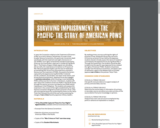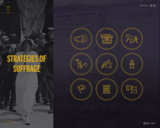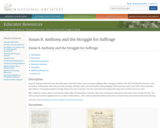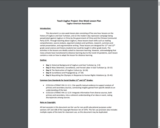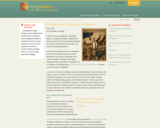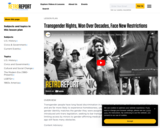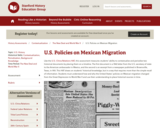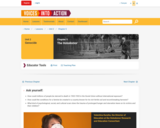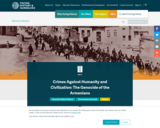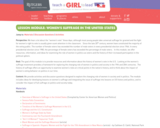This series of eight lessons is organized as a mini-unit for teaching the Armenian Genocide. They were designed to complement Facing History and Ourselves' resource books, Holocaust and Human Behavior and Crimes Against Humanity and Civilization: The Genocide of the Armenians. Most of these lessons are designed to be used with the film The Armenian Genocide (Two Cats Productions), which aired on PBS on April 17, 2006 and is available to borrow from our library or stream if you are in our educator network. These texts depict, in words or images, evidence of horrible atrocities such as murder and starvation. We recommend previewing materials in order to gauge if they are appropriate given the maturity level of your students.
While we estimate that teaching all eight lessons would require approximately 10 hours of class time, we know that the actual pacing of these lessons depends on your students and your context. These lessons can also by used individually with the understanding that the later lessons rely on students' previous knowledge of the Armenian Genocide. It is our hope that you use these lessons as a jumping off point in creating learning experiences that will engage students in the history of the Armenian Genocide and the important questions this history raises about human behavior.
Language note: While this unit is titled "The Genocide of the Armenians," the word genocide did not exist in 1915 when the Armenians were being massacred and forced on death marches. To avoid historical anachronism, the first seven lessons of this unit circumvent the use of the word "genocide" with students. The final lesson introduces students to the modern term "genocide," and to the different ways people claim or deny this term. You might choose to introduce students to the term "genocide" earlier in the unit, while informing them that the events they are learning about inspired the genesis of this term.
Something to think about: The purpose of these lessons is to help students understand a particular moment in history, the Armenian Genocide, as a way to explore core questions about human behavior. While students are asked to travel across time and space in order to connect this history to their own ideas and experiences, it would be irresponsible for students to make generalizations about a particular religious or national group that cuts across time and place. In other words, students should be strongly discouraged from seeing this history as a lesson about all Turks, all Muslims, all Armenians, or all Americans, in the same way that scholars who teach about the Holocaust are careful not to condemn all Germans or all Christians for acts committed by the Nazis and their followers.
Background
In our increasingly interconnected world it has become clear that what happens in one country affects all of us in many ways, some more visible than others. Responding to genocide, ethnic violence, and abuses of human rights stand as the primary challenges of our day. There was great hope that the end of the Cold War would usher in a new era with a blossoming of democracy and human rights; instead violence around the world makes it clear that finding the tools to prevent genocide is as urgent as ever. Historians note that in the last hundred years more human beings died through genocidal violence and state-sanctioned murder than on that era's countless battlefields.
It was no accident that the failure to prevent escalating abuses of the human rights of Ottoman minorities climaxed with the systematic deportation and mass murder of the Armenian population of the empire in World War I. While other minority groups had broken free from the Ottoman Empire, the Armenians hoped that reforms--supported by the Western powers-would bring change. Instead a new nationalism spread through the Ottoman leadership that left no place for the Christian minorities within the empire. Under the cover of World War I the genocide of the Armenians began.
In 1915 journalists, politicians, and ordinary people considered how best to respond to the accounts of "horrors" and "outrages" in Turkey's Anatolian desert. Unable to remain silent, local and national leaders challenged tradition by boldly proclaiming that responsibility for human life does not stop at national borders. Their solutions set important precedents for international law. In fact, the phrase "crimes against humanity," made famous as one of the counts at the post-Holocaust Nuremberg Trials, was first used to describe the massacres of Armenian civilians in the spring of 1915.
As the pillaging of Armenian villages continued, diplomats debated questions of national sovereignty. In the absence of military intervention, coalitions of individuals, religious groups, and voluntary associations were able to raise millions of dollars to house and feed refugees from the slaughter. While those efforts saved many, humanitarian relief alone could not stop the mass murder of women, children, and men. In the wake of the genocide, official promises to hold the perpetrators accountable faded, as did support for the new Armenian state.
To many who had followed the bloody history of Turkey's campaign against its own people, the impunity enjoyed by those who had ordered and carried out the killings was unbearable. One of them was Raphael Lemkin, a Polish Jew and a law student. Lemkin confronted one of his law school professors. He asked, "Why is the killing of a million people a lesser crime than the killing of a single individual?" His professor used a metaphor to explain that courts did not have any jurisdiction: "Consider the case of a farmer who owns a flock of chickens. He kills them and this is his business. If you interfere, you are trespassing." But, replied an incensed Lemkin, "the Armenians are not chickens." Lemkin dedicated the rest of his life to finding a way to make sure that the law would recognize the difference. In 1944 Lemkin coined the word "genocide" and later he drafted the United Nations Convention on Genocide. The convention was ratified on December 9, 1948, one day before the adoption of the Universal Declaration of Human Rights.
Although this convention requires that its signatories take whatever steps are necessary to prevent genocide, too often the international community does little but stand by while mass killings continue in places like Sudan and the Democratic Republic of the Congo. In his role as a columnist for the New York Times, Nicholas Kristoff warns readers about the consequences of silence. "There is something special about genocide," he writes, "When human beings deliberately wipe out others because of their tribe or skin color, when babies succumb not to diarrhea but to bayonets and bonfires, that is not just one more tragedy. It is a monstrosity that demands a response from other humans. We demean our own humanity, and that of the victims, when we avert our eyes."
We hope that this series of lessons will help a new generation to understand that genocide is a threat to all of us: it is indeed a "crime against humanity."
